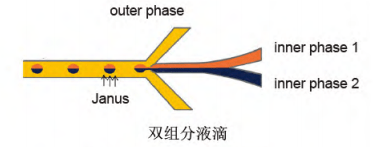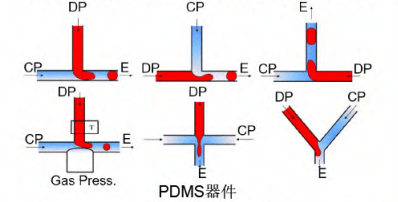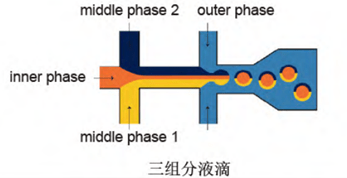Droplets, granules and capsules are excellent carriers for active substances, therapeutic drugs and tissue cells and are widely used in biomedicine, food and cosmetics.
For example, capsules can encapsulate active substances such as probiotics and vitamins for hermetically sealed storage and controlled release. During storage, the capsule protects the active substance from adverse factors such as light and oxygen, enhancing its stability and storage time.
When applied, the capsule can release the active substance slowly, such as by diffusion, or quickly, such as by mechanical extrusion or wall dissolution, in order to realize the control of the release of the active substance.
In the biomedical field, droplets, granules and capsules are used as novel carriers for drugs to control drug release and reduce toxic side effects.
For example, anticancer drugs are often cytotoxic, and rapid release may lead to excessive concentrations that damage normal cells. Controlling the slow release of drugs through droplets, pellets or capsules can reduce toxicity and enable efficient delivery.
Microfluidics enables precise control of the fluid and thus the emulsification process to prepare droplets of controllable size, uniform dimensions and adjustable structure. Using the droplets as templates, particles and capsules of controllable size, uniform size and adjustable structure can be further prepared.
Microfluidic controlled preparation of droplets and its applications
Conventional kettle stirring methods lack control over the emulsification process, resulting in the preparation of droplets of uneven size. Microfluidic technology prepares droplets of controllable size, homogeneous size and tunable structure by precisely controlling the shearing process in microchannels.

Under the shearing action of the continuous phase, the dispersed phase forms droplets of uniform size, which may comprise single-component, two-component or three-component forms.

Common PDMS microfluidic devices include T-type, cross-type, and Y-type.The advantages of PDMS microfluidic devices are biocompatibility and the ability to design complex channel structures.

However, the disadvantage is the low solvent resistance, which may lead to PDMS solubilization. In addition, the two-dimensional channel structure is not conducive to fluid shear emulsification.

In the case of preparing PDMS microfluidic devices with water-in-oil single-emulsion droplets, for example, it is necessary to ensure that the continuous-phase oil phase can wet the channel surfaces well, and thus the channel surfaces must be hydrophobized.
Microfluidics has a wide range of applications in the food field, such as the preparation of protein emulsions.
Using a PDMS microfluidic device, sunflower oil can be emulsified into oil droplets of uniform size and the stability of the droplets can be enhanced by adsorption of soy protein at the oil/water interface, thus constructing a dispersed size-uniform sunflower oil droplet soy protein food emulsion.
Microfluidics allows precise control of the size and structure of the droplets, while 3D printing allows precise control of the spatial arrangement of the droplets.
Combining microfluidics with 3D printing to form microfluidic 3D droplet printing technology allows for controlled preparation of droplet arrays.
The modified 3D printing device utilizes a 3D printing platform to control microfluidics, and both microfluidic and microfluidic 3D droplet printing to prepare suspended droplets for applications such as skin care products.
Microfluidic controllable particles and their applications
Since microfluidics enables precise preparation of single emulsion droplets, these emulsion droplets can be used as templates for further preparation of particles by solvent evaporation, ionic cross-linking, photocross-linking and chemical cross-linking.
Compared with the traditional spray drying and stirring emulsification methods, the particles prepared by microfluidic control have the advantages of controllable particle size, uniform size, and good reproducibility, which are widely used in the fields of food and biomedicine.
In the biomedical field, hydrogel particles can be used to encapsulate cells and provide them with a three-dimensional microenvironment, which is widely used in cell culture and tissue regeneration.
For example, sodium alginate hydrogel particles prepared by ionic cross-linking to encapsulate MSCs can protect the viability and function of stem cells and enable stem cell delivery therapy for bone defects in a minimally invasive manner.
Hydrogel particles not only encapsulate cells but also load drugs for controlled delivery.
For example, injectable hydrogel particles prepared by photocrosslinking can be loaded with the anti-inflammatory drug diclofenac sodium, which realizes the long-lasting effect of the drug in the knee joint of rats through slow release, providing a new solution for arthritis treatment.
In addition to solvent volatilization, ionic cross-linking and photocross-linking, chemical cross-linking is also commonly used for particle preparation. Hydrogel particles prepared by chemical cross-linking can be engineered with inter-particle interactions and assembled into cell growth scaffolds to promote cell migration and tissue regeneration.
Microfluidic Controlled Preparation of Capsules and Their Applications
Capsules usually consist of a shell layer wrapped around an inner core, forming a core-shell structure. Microfluidics usually uses double-emulsion droplets as a template for capsule preparation.
First, oil-in-water or water-in-oil double emulsion droplets are prepared by microfluidic devices, and then stabilized capsules are obtained by solvent evaporation, ionic cross-linking, and chemical cross-linking.
Microfluidic devices control the fluid flow and shear process by precisely designing the channel structure, so as to prepare capsules with uniform size, controllable wall thickness, high encapsulation rate and simple operation.
For applications such as food and biomedicine, capsule shell layers are often made of biocompatible materials such as sodium alginate, collagen, polyvinyl alcohol, and polyethylene glycol, which prolong the storage time of the encapsulated material and enable its controlled release.
Although capsules are usually prepared using double-emulsion droplets as templates, capsules can also be prepared by using single-emulsion droplets as templates. In this method, the polymer is deposited at the oil/water interface by solvent volatilization, forming capsules encapsulating oil droplets.
In contrast, the preparation of double-emulsion droplets usually requires complex microfluidic devices that cannot be easily scaled up, while the preparation of single-emulsion droplets is relatively simple and easier to achieve high-throughput preparation.
Capsules with a core-shell structure have a wide range of applications in fields such as biomedicine, where the core and shell layers can be loaded with different cells to construct organ models.
For example, using water-in-water double emulsion droplets as templates, sodium alginate hydrogel capsules are prepared by calcium ion cross-linking, in which the aqueous-phase kernel can encapsulate hepatocytes, and the hydrogel shell layer can encapsulate fibroblasts, so as to construct a liver-like organ model for drug screening and other applications.
Site Search
Recommendations
© 2025. All Rights Reserved. 苏ICP备2022036544号-1













